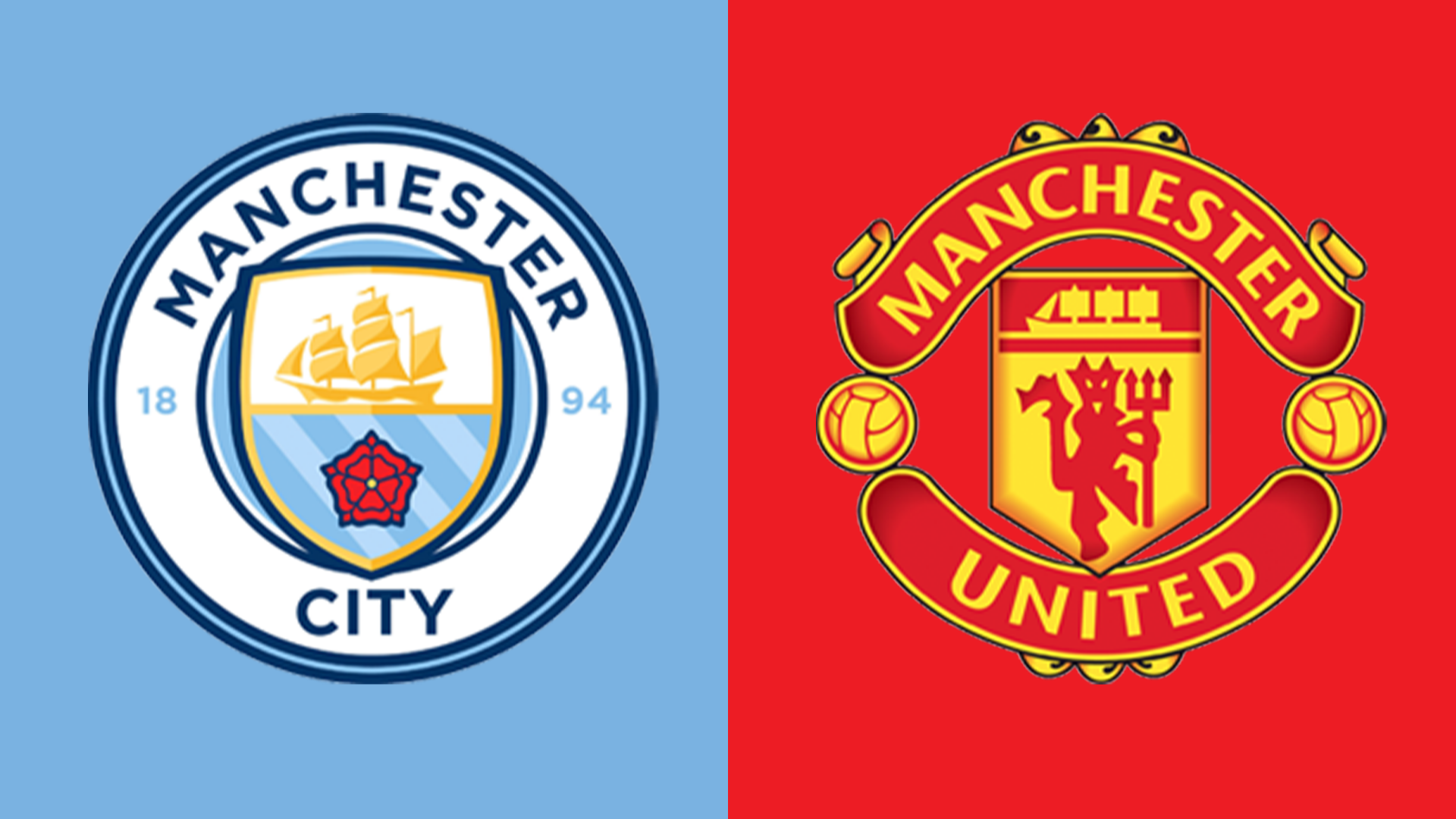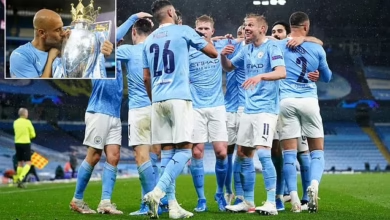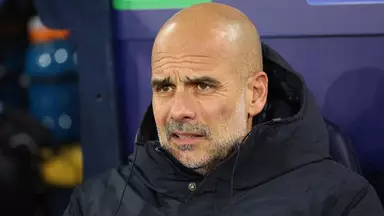Man City are interested in Man United target Denzel Dumfries

The summer transfer window has delivered yet another intriguing subplot in the eternal rivalry between Manchester’s two footballing giants. As both Manchester United and Manchester City find themselves locked in pursuit of the same target, the saga surrounding Dutch international Denzel Dumfries has evolved into a fascinating case study of modern football’s transfer dynamics, tactical evolution, and the ever-present specter of Financial Fair Play regulations.
The Foundation of Interest
Manchester United’s interest in Denzel Dumfries is far from a recent development. The Red Devils’ pursuit of the Dutch fullback can be traced back to the tenure of Erik ten Hag, when the former Ajax manager identified his compatriot as a potential solution to the club’s persistent defensive vulnerabilities. This long-term interest speaks volumes about the continuity of United’s transfer strategy, even as managerial changes have swept through Old Trafford.
The foundation of this interest lies in Dumfries’ unique profile as a modern fullback. In an era where the traditional boundaries between defense and attack have become increasingly blurred, players like Dumfries represent the evolution of the position. His ability to contribute meaningfully in both phases of the game has made him an attractive proposition for clubs seeking to maximize their tactical flexibility.
Ten Hag’s initial interest in Dumfries was rooted in a deeper understanding of the player’s capabilities, having witnessed firsthand the Dutch international’s development within the Eredivisie. The manager’s tactical philosophy, which emphasizes width and attacking thrust from fullback positions, identified Dumfries as an ideal candidate to implement this approach at the highest level of European football.
A Season of Stellar Performances
The 2024-25 season has served as a showcase for Dumfries’ exceptional abilities, with his performances reaching new heights on football’s biggest stages. His contributions throughout the campaign have been nothing short of remarkable, but it was his displays in the Champions League semi-final against Barcelona that truly captured the attention of Europe’s elite clubs.
Over the course of two legs against the Catalan giants, Dumfries delivered a masterclass in modern fullback play. His tally of two goals and three assists across the semi-final ties demonstrated not only his technical proficiency but also his ability to rise to the occasion when the stakes are highest. These performances showcased the complete package that has made him such an attractive target for top-tier clubs.
The goals themselves were a testament to his positioning and finishing ability, qualities that extend far beyond what is typically expected from a defensive player. His assists, meanwhile, highlighted his vision and crossing ability, demonstrating the kind of creative output that has become increasingly valuable in contemporary football tactics.
Beyond the raw statistics, Dumfries’ performances against Barcelona revealed his mental fortitude and big-game temperament. The pressure of Champions League semi-final football, played in front of a global audience, can overwhelm even the most talented players. Yet Dumfries thrived in this environment, suggesting that he possesses the psychological attributes necessary to succeed at the very highest level.
The Financial Dynamics
Perhaps the most intriguing aspect of the Dumfries situation is the financial component that has made his transfer increasingly viable for interested clubs. His release clause, which has dropped to €25 million until the middle of July, represents exceptional value in today’s inflated transfer market. This figure is particularly striking when compared to the fees commanded by players of similar ability and profile.
The timing of this release clause creates a fascinating dynamic in the transfer market. The mid-July deadline creates a sense of urgency that benefits clubs capable of making quick decisions while potentially disadvantaging those with more complex decision-making processes. This temporal element adds another layer of complexity to an already intricate transfer situation.
The relatively modest fee also reflects the current economic realities facing many European clubs. In a market where fullbacks of far lesser ability routinely command fees in excess of €40 million, Dumfries’ release clause represents a rare opportunity for clubs to secure top-tier talent at a reasonable price. This financial accessibility has naturally increased the competition for his signature.
The Agent Change Strategy
Dumfries’ decision to change agents represents a calculated move designed to facilitate his desired transfer. This strategic shift in representation often signals a player’s serious intent to secure a move, as new agents typically bring fresh perspectives, different relationships, and alternative approaches to negotiations.
The timing of this agent change is particularly significant, coming as it does during a crucial period in the transfer window. New representation can often break through stalled negotiations or open up previously unexplored avenues for potential moves. The change suggests that Dumfries is actively seeking to engineer his departure, rather than passively waiting for circumstances to align.
This proactive approach from the player’s camp indicates a level of ambition that aligns with the interest from top-tier clubs. It demonstrates that Dumfries is not content to remain in his current situation and is willing to take concrete steps to secure a move that he believes will further his career development.
Barcelona’s Complicated Interest
FC Barcelona’s interest in Dumfries adds another dimension to the transfer saga, though their ability to compete for his signature has been significantly compromised by their ongoing Financial Fair Play constraints. The Catalan giants’ well-documented financial difficulties have forced them to prioritize their spending, leading to difficult decisions about which targets to pursue most aggressively.
The club’s decision to prioritize the signing of former Espanyol goalkeeper Joan Garcia over Dumfries illustrates the harsh realities of operating under financial constraints. This choice reflects not only their immediate tactical needs but also their assessment of which positions require the most urgent attention given their limited resources.
Barcelona’s financial situation serves as a cautionary tale for modern football clubs, demonstrating how past fiscal mismanagement can severely limit future transfer activities. Despite their interest in Dumfries, their inability to compete effectively for his signature highlights the growing importance of sustainable financial management in contemporary football.
The irony of Barcelona’s situation is particularly striking given their historical ability to attract top talent. The club’s reduced circumstances have fundamentally altered their position in the transfer market, forcing them to adopt a more strategic and selective approach to player recruitment.
Manchester City’s Emergence
The emergence of Manchester City as a serious contender for Dumfries’ signature has transformed the dynamics of the transfer race. According to reports from Catalan newspaper Mundo Deportivo, City have positioned themselves ahead of Barcelona in the pursuit of the Dutch international, bringing their considerable resources and attractive project to bear on the situation.
Transfer journalist Steve Kay’s claims that City “are already on the trail of Dumfries” and have begun talks for the player suggest that the club’s interest has moved beyond mere speculation into concrete action. This development represents a significant escalation in the competition for the player’s services and introduces a new level of complexity to Manchester United’s pursuit.
City’s involvement in the race for Dumfries reflects their ongoing commitment to squad improvement and tactical evolution. Despite their recent successes, the club continues to identify areas for enhancement, demonstrating the relentless pursuit of excellence that has characterized their approach under Pep Guardiola.
The strategic rationale behind City’s interest becomes clearer when viewed through the lens of their current squad composition and future planning. The club’s assessment that they need to “finally replace Kyle Walker” indicates a recognition that even successful squads require constant renewal to maintain their competitive edge.
The Kyle Walker Factor
Kyle Walker’s role in Manchester City’s success cannot be overstated. The England international has been described as “instrumental” to City’s achievements in recent years, providing pace, defensive solidity, and attacking threat from the right-back position. His contributions have been central to City’s tactical approach, particularly in their ability to maintain defensive stability while committing numbers to attack.
However, Walker’s advancing age and the physical demands of modern football have prompted City to begin planning for his eventual replacement. At 34, Walker remains an effective player, but the club’s forward-thinking approach to squad management recognizes the need to identify and integrate his successor before his performances begin to decline.
The search for Walker’s replacement represents a significant challenge for City’s recruitment team. Finding a player capable of replicating his unique combination of pace, defensive awareness, and attacking contribution is no simple task. Dumfries’ profile suggests that City believe they have identified a player capable of filling this crucial role.
The transition from Walker to his replacement will require careful management from Pep Guardiola and his coaching staff. The tactical adjustments necessary to accommodate a new player’s different strengths and weaknesses could have far-reaching implications for City’s overall approach to the game.
Tactical Implications
The pursuit of Dumfries by both Manchester clubs reflects broader tactical trends in modern football. The increasing importance of fullbacks in contemporary tactics has elevated players like Dumfries to positions of significant value and influence. Their ability to contribute meaningfully in both defensive and attacking phases makes them crucial components of successful teams.
For Manchester United, the acquisition of Dumfries would represent a significant upgrade in their attacking output from wide areas. His ability to create chances and score goals from fullback positions would add a new dimension to their tactical approach, providing additional routes to goal and creative options for their attacking players.
The Dutch international’s pace and crossing ability would be particularly valuable in United’s tactical system. His capacity to stretch opposition defenses and deliver quality service into the penalty area could prove instrumental in unlocking stubborn defensive setups.
For Manchester City, Dumfries would offer a slightly different profile compared to Walker, potentially allowing for tactical variations while maintaining the high level of performance they have come to expect from the position. His greater goal threat could add an extra dimension to City’s already potent attacking arsenal.
The Manchester Derby Dimension
The involvement of both Manchester clubs in the pursuit of Dumfries adds an extra layer of intrigue to the transfer saga. The cross-city rivalry between United and City has extended beyond the pitch into the transfer market, with both clubs often finding themselves competing for the same targets.
This competition serves multiple purposes beyond simply securing the player’s services. Successfully outmaneuvering their city rivals in the transfer market can provide psychological advantages and demonstrate relative strength in the modern football landscape. The symbolic value of winning such battles can be almost as important as the practical benefits of securing the player.
The Manchester derby dimension also raises the stakes for both clubs. Allowing their city rivals to secure a target while they fail to do so can be seen as a sign of weakness or poor planning. This dynamic often leads to escalated bids and more aggressive pursuit strategies.
For United, successfully securing Dumfries ahead of City would represent a significant statement of intent. It would demonstrate their ability to compete with their more successful neighbors in the transfer market and potentially signal a shift in the balance of power within Manchester football.
The Broader Transfer Market Context
The Dumfries situation exists within the broader context of a transfer market that has become increasingly complex and competitive. The convergence of multiple elite clubs on a single target has become commonplace, driven by the global nature of modern football scouting and the limited pool of truly elite talent.
The financial dynamics of contemporary football have created a situation where clubs must balance ambitious transfer targets with Financial Fair Play compliance. This has led to more strategic and selective approaches to player recruitment, with clubs forced to prioritize their spending on players who can make immediate and significant impacts.
The timing pressures created by release clauses and contract situations have added another layer of complexity to transfer negotiations. Clubs must now operate with greater urgency and decisiveness, as delay can often result in missing out on targets to more proactive competitors.
Conclusion: A Transfer Saga with Wider Implications
The pursuit of Denzel Dumfries by Manchester United and Manchester City represents more than just a simple transfer story. It encapsulates many of the key themes and challenges facing modern football: the evolution of tactical roles, the impact of Financial Fair Play regulations, the importance of strategic timing, and the ongoing arms race between elite clubs.
The ultimate resolution of this transfer saga will likely depend on a combination of factors including the player’s personal preferences, the clubs’ respective negotiating skills, and their ability to present compelling sporting projects. The winner of this particular battle may not only secure a talented player but also gain psychological advantages in their ongoing rivalry.
As the July deadline for Dumfries’ release clause approaches, the intensity of competition is likely to increase. Both Manchester clubs will need to demonstrate their commitment to securing his signature through concrete action rather than mere interest. The coming weeks will reveal which club possesses the combination of ambition, strategy, and execution necessary to secure one of the summer’s most intriguing transfer targets.
The Dumfries saga serves as a microcosm of modern football’s transfer dynamics, illustrating how player movements have become increasingly complex operations involving multiple stakeholders, competing interests, and significant financial implications. Regardless of the outcome, this transfer story will provide valuable insights into the current state of the football transfer market and the evolving strategies of Europe’s elite clubs.














